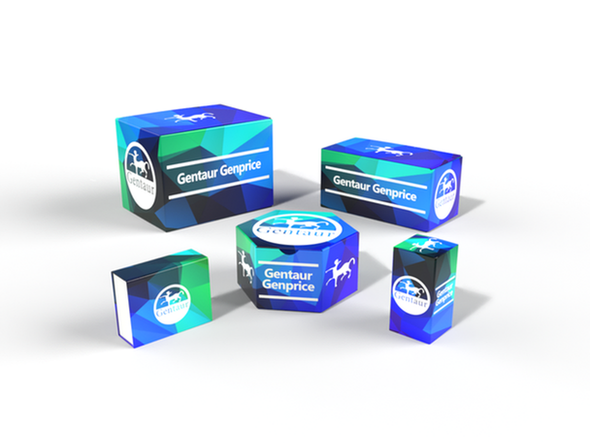Description
RNF26 Antibody | 8549 | Gentaur UK, US & Europe Distribution
Host: Rabbit
Reactivity: Human, Rat
Homology: Predicted species reactivity based on immunogen sequence: Mouse: (79%)
Immunogen: RNF26 antibody was raised against a peptide corresponding to 14 amino acids near the amino terminus of human RNF26.
Research Area: Cell Cycle, Cancer
Tested Application: E, WB
Application: RNF26 antibody can be used for Western blot at 1 - 2 μg/mL.
Antibody validated: Western Blot in human and rat samples. All other applications and species not yet tested.
Specificiy: RNF26 Antibody is predicted to not cross-react with other CXCR familiy members.
Positive Control 1: Cat. No. 1315 - Human Tonsil Tissue Lysate
Positive Control 2: Cat. No. 1475 - Rat Stomach Tissue Lysate
Positive Control 3: N/A
Positive Control 4: N/A
Positive Control 5: N/A
Positive Control 6: N/A
Molecular Weight: Predicted: 48 kDa
Observed: 50 kDa
Validation: N/A
Isoform: N/A
Purification: RNF26 Antibody is affinity chromatography purified via peptide column.
Clonality: Polyclonal
Clone: N/A
Isotype: IgG
Conjugate: Unconjugated
Physical State: Liquid
Buffer: RNF26 Antibody is supplied in PBS containing 0.02% sodium azide.
Concentration: 1 mg/mL
Storage Condition: RNF26 antibody can be stored at 4˚C for three months and -20˚C, stable for up to one year. As with all antibodies care should be taken to avoid repeated freeze thaw cycles. Antibodies should not be exposed to prolonged high temperatures.
Alternate Name: RNF26 Antibody: FB22, HM89, LAP3, LCR1, NPYR, WHIM, CD184, LESTR, NPY3R, NPYRL, HSY3RR, NPYY3R, D2S201E
User Note: Optimal dilutions for each application to be determined by the researcher.
BACKGROUND: RNF26 Antibody: RNF26 was identified as a member of a novel C3HC5 ring finger subfamily (1) . RNF26 is ubiquitously expressed in human tissues but has been found to be upregulated in several cancer cell lines including HL-60, HeLa S3, and SW480, as well as 50% of primary gastric cancers. While the substrates of RNF26 ubiquitination have not yet been identified, the upregulation of RNF26 in several types of cancer suggest that it may serve as a target for therapeutic treatment (1) .



![RNF26 Antibody (Center) [APR31655G] RNF26 Antibody (Center) [APR31655G]](https://cdn11.bigcommerce.com/s-1rdwiq712m/images/stencil/590x590/products/62798/63102/gentaur-genprice__26005.1661610467__29809.1661628092__75433.1661676199__77988.1661684280__64362.1661692443__34884.1661865887.png?c=1)


